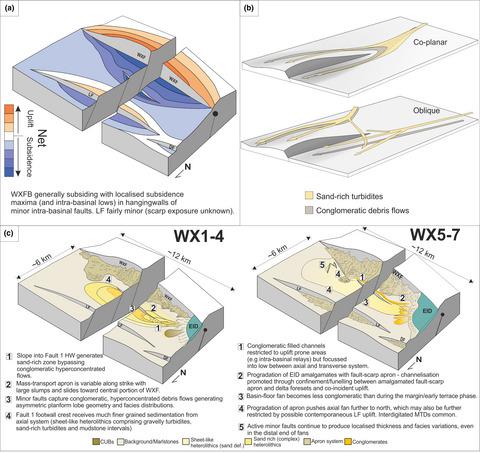当前位置:
X-MOL 学术
›
Basin Res.
›
论文详情
Our official English website, www.x-mol.net, welcomes your
feedback! (Note: you will need to create a separate account there.)
Axial and transverse deep‐water sediment supply to syn‐rift fault terraces: insights from the West Xylokastro Fault Block, Gulf of Corinth, Greece
Basin Research ( IF 2.8 ) Pub Date : 2019-11-08 , DOI: 10.1111/bre.12416 Timothy M. Cullen 1, 2 , Richard E. Ll. Collier 1 , Robert L. Gawthorpe 2 , David M. Hodgson 1 , Bonita J. Barrett 1
Basin Research ( IF 2.8 ) Pub Date : 2019-11-08 , DOI: 10.1111/bre.12416 Timothy M. Cullen 1, 2 , Richard E. Ll. Collier 1 , Robert L. Gawthorpe 2 , David M. Hodgson 1 , Bonita J. Barrett 1
Affiliation

|
[Deep‐water syn‐rift depocentres are characterised by short transport distances, coarse grain sizes and variety of sedimentary processes, all of which interact with complex intra‐basinal topography and structural evolution (a). This axial depositional system interacts with coeaval, mass‐transport dominated transverse systems sourced from the growing West Xylokastro Fault to shift the locus of sedimentation in the axial system far from the immediate hangingwall region in what is ultimately a relatively narrow (5‐6 km) fault terrace. Abrupt changes in stratigraphic architecture across the axial system record relative base‐level, sediment supply and subsidence variability which is complicated by local depositional topography and intra‐basinal structures (b). Exhumed systems can help constrain the tectono‐stratigraphic evolution of such systems, however these are rare or often complicated by inversion tectonics. However, the West Xylokastro Fault Block (Gulf of Corinth, Greece) offers superb exposures of an Early‐Mid Pleistocene Gilbert‐type fan delta and downdip, axial deep‐water depositional system in the hangingwall of a rift margin fault (c). Here we provide new conceptual models for the evolution of multi‐input, deep‐water syn‐rift depocentres and characterise the scale and nature of the variability of depositional systems within them. , Abstract Deep‐water syn‐rift systems develop in partially‐ or transiently‐linked depocentres to form complicated depositional architectures, which are characterised by short transport distances, coarse grain sizes and a wide range of sedimentary processes. Exhumed systems that can help to constrain the tectono‐stratigraphic evolution of such systems are rare or complicated by inversion tectonics. Here, we document a mid‐Pleistocene deep‐water syn‐rift system fed by Gilbert‐type fan deltas in the hangingwall of a rift margin fault bounding the West Xylokastro Horst block, on the southern margin of the Gulf of Corinth, Greece. Structural and stratigraphic mapping combined with digital outcrop models permit observations along this syn‐rift depositional system from hinterland source to deep‐water sink. The West Xylokastro Fault hangingwall is filled by two distinct sediment systems; an axial system fed by coarse‐grained sediment gravity flows derived from fault‐tip Gilbert‐type fan deltas and a lateral system dominated by mass transport deposits fed from an evolving fault‐scarp apron. Abrupt changes in stratigraphic architecture across the axial system are interpreted to record changes in relative base level, sediment supply and tectonics. Locally, depositional topography and intra‐basinal structures controlled sediment dispersal patterns, from bed‐scale infilling of local rugose topography above mass transport complexes, to basin‐scale confinement from the fault scarp apron. These acted to generate a temporally and spatially variable, heterogeneous stratigraphic architecture throughout the basin‐fill. The transition of the locus of sedimentation from a rift margin to a fault terrace through the syn‐sedimentary growth of a basinward fault produced regressive surfaces updip, which manifest themselves as channels in the deep‐water realm and acted to prograde the system. We present a new conceptual model that recognises coeval axial and transverse systems based on the stratigraphic architecture around the West Xylokastro fault block that emphasizes the lateral and vertical heterogeneity of rift basin‐fills with multiple entry points.]
中文翻译:

同裂谷断层阶地的轴向和横向深水沉积物供应:来自希腊科林斯湾西 Xylokastro 断块的见解
[深水同裂谷沉积中心的特点是运输距离短、粒度粗、沉积过程多样,所有这些都与复杂的盆地内地形和构造演化相互作用(a)。这种轴向沉积系统与源自不断增长的西 Xylokastro 断层的相邻的、以质量传输为主的横向系统相互作用,从而将轴向系统中的沉积位置远离直接的上盘区域,最终形成一个相对狭窄的区域(5-6 公里)断层台。轴向系统地层结构的突然变化记录了相对基础水平、沉积物供应和沉降的变化,而局部沉积地形和盆地内结构使这些变化变得复杂(b)。挖掘出的系统可以帮助限制此类系统的构造地层演化,然而,这些是罕见的或经常被反转构造复杂化。然而,西 Xylokastro 断块(希腊科林斯湾)提供了早中更新世吉尔伯特型扇三角洲和下倾的轴向深水沉积系统在裂谷边缘断层(c)上的极好的暴露。在这里,我们为多输入、深水同裂谷沉积中心的演化提供了新的概念模型,并表征了其中沉积系统变化的规模和性质。, 摘要 深水同裂谷系统在部分或瞬时连接的沉积中心发育,形成复杂的沉积结构,其特点是输运距离短、粒度粗和沉积过程范围广泛。有助于限制此类系统构造地层演化的挖掘系统很少见或因反转构造而变得复杂。在这里,我们记录了一个中更新世深水同裂谷系统,该系统由位于希腊科林斯湾南缘西 Xylokastro Horst 地块边界的裂谷边缘断层的上盘中的吉尔伯特型扇三角洲供给。结构和地层绘图与数字露头模型相结合,允许沿着这个同裂谷沉积系统从腹地源到深水汇进行观测。西 Xylokastro 断层上墙被两个不同的沉积系统填充;由断层尖端吉尔伯特型扇三角洲产生的粗粒沉积物重力流供给的轴向系统和由演化中的断层陡崖供给的质量输送沉积物主导的侧向系统。轴向系统地层结构的突然变化被解释为记录相对基础水平、沉积物供应和构造的变化。在局部,沉积地形和盆地内结构控制着沉积物的扩散模式,从质量输送复合体上方局部皱纹地形的床尺度填充,到断层陡坡裙带的盆地尺度限制。这些作用在整个盆地填充物中产生了时间和空间可变的异质地层结构。通过向盆地断层的同沉积生长,沉积地点从裂谷边缘到断层阶地的转变产生了上倾的回归表面,这些表面表现为深水领域的通道,并起到了推进系统的作用。
更新日期:2019-11-08
中文翻译:

同裂谷断层阶地的轴向和横向深水沉积物供应:来自希腊科林斯湾西 Xylokastro 断块的见解
[深水同裂谷沉积中心的特点是运输距离短、粒度粗、沉积过程多样,所有这些都与复杂的盆地内地形和构造演化相互作用(a)。这种轴向沉积系统与源自不断增长的西 Xylokastro 断层的相邻的、以质量传输为主的横向系统相互作用,从而将轴向系统中的沉积位置远离直接的上盘区域,最终形成一个相对狭窄的区域(5-6 公里)断层台。轴向系统地层结构的突然变化记录了相对基础水平、沉积物供应和沉降的变化,而局部沉积地形和盆地内结构使这些变化变得复杂(b)。挖掘出的系统可以帮助限制此类系统的构造地层演化,然而,这些是罕见的或经常被反转构造复杂化。然而,西 Xylokastro 断块(希腊科林斯湾)提供了早中更新世吉尔伯特型扇三角洲和下倾的轴向深水沉积系统在裂谷边缘断层(c)上的极好的暴露。在这里,我们为多输入、深水同裂谷沉积中心的演化提供了新的概念模型,并表征了其中沉积系统变化的规模和性质。, 摘要 深水同裂谷系统在部分或瞬时连接的沉积中心发育,形成复杂的沉积结构,其特点是输运距离短、粒度粗和沉积过程范围广泛。有助于限制此类系统构造地层演化的挖掘系统很少见或因反转构造而变得复杂。在这里,我们记录了一个中更新世深水同裂谷系统,该系统由位于希腊科林斯湾南缘西 Xylokastro Horst 地块边界的裂谷边缘断层的上盘中的吉尔伯特型扇三角洲供给。结构和地层绘图与数字露头模型相结合,允许沿着这个同裂谷沉积系统从腹地源到深水汇进行观测。西 Xylokastro 断层上墙被两个不同的沉积系统填充;由断层尖端吉尔伯特型扇三角洲产生的粗粒沉积物重力流供给的轴向系统和由演化中的断层陡崖供给的质量输送沉积物主导的侧向系统。轴向系统地层结构的突然变化被解释为记录相对基础水平、沉积物供应和构造的变化。在局部,沉积地形和盆地内结构控制着沉积物的扩散模式,从质量输送复合体上方局部皱纹地形的床尺度填充,到断层陡坡裙带的盆地尺度限制。这些作用在整个盆地填充物中产生了时间和空间可变的异质地层结构。通过向盆地断层的同沉积生长,沉积地点从裂谷边缘到断层阶地的转变产生了上倾的回归表面,这些表面表现为深水领域的通道,并起到了推进系统的作用。











































 京公网安备 11010802027423号
京公网安备 11010802027423号